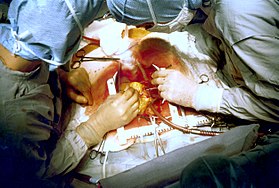Cardiac surgery
| Cardiac surgery | |
|---|---|
| Intervention | |

Two cardiac surgeons performing a cardiac surgery known as coronary artery bypass surgery. Note the use of a steel retractor to forcefully maintain the exposure of the patient's heart.
|
|
| ICD-9-CM | 35-37 |
| MeSH | D006348 |
| OPS-301 code | 5-35...5-37 |
Cardiovascular (heart) surgery is surgery on the heart or great vessels performed by cardiac surgeons. Frequently, it is done to treat complications of ischemic heart disease (for example, coronary artery bypass grafting), correct congenital heart disease, or treat valvular heart disease from various causes including endocarditis, rheumatic heart disease and atherosclerosis. It also includes heart transplantation.
The development of cardiac surgery and cardiopulmonary bypass techniques has reduced the mortality rates of these surgeries to relatively low ranks. For instance, repairs of congenital heart defects are currently estimated to have 4–6% mortality rates. A major concern with cardiac surgery is the incidence of neurological damage. Stroke occurs in 2–3% of all people undergoing cardiac surgery, and is higher in patients at risk for stroke. A more subtle complication of neurocognitive deficits attributed to cardiopulmonary bypass is known as postperfusion syndrome, sometimes called "pumphead". The symptoms of postperfusion syndrome were initially felt to be permanent, but were shown to be transient with no permanent neurological impairment.
The most common complications after heart surgery include postoperative atrial fibrillation, which occurs in nearly 1 in 3 patients, retained blood syndrome, which occurs in 1 in 4 patients, bloodypleural effusions which occur in 1 in 10 patients, and infections, that occur in approximately 1 in 20 patients. Hospital readmissions often occur in cardiac surgery patients; in 2010, approximately 18.5% of patients who had a heart valve procedure in the United States were readmitted within 30 days of the initial hospitalization. Readmissions are primarily related to these common complications such as postoperative atrial fibrillation, retained blood syndrome and pleural effusions and infections, thus prompting new efforts to prevent problems like chest tube clogging that contribute to these problems. Reducing costs, complications and readmissions primarily focus on addressing these common complications.
...
Wikipedia
